Line and Rigging
Soft Shackle Y-Sheet
 Y-Sheet use for spinnakers is not a new idea. In fact, it is widely used but typically requires tying to the clew with a bowline. That makes using high-tech lines like Amsteel problematic because knots slip in Dyneema. In this implementation, the attachment to the clew is just like a soft shackle. But unlike a traditional soft shackle, the shackle is divided into its key elements with the adjustable eye integrated in the Y-Sheet itself, and the diamond knot permanently attached to the clew ring. This keeps the advantage of the Y-Sheet in terms of reducing snagging on tacks in the case of a jib and jibes in the case of an asymmetric spinnaker.
Y-Sheet use for spinnakers is not a new idea. In fact, it is widely used but typically requires tying to the clew with a bowline. That makes using high-tech lines like Amsteel problematic because knots slip in Dyneema. In this implementation, the attachment to the clew is just like a soft shackle. But unlike a traditional soft shackle, the shackle is divided into its key elements with the adjustable eye integrated in the Y-Sheet itself, and the diamond knot permanently attached to the clew ring. This keeps the advantage of the Y-Sheet in terms of reducing snagging on tacks in the case of a jib and jibes in the case of an asymmetric spinnaker.
It is much easier to attach this kind of shackle than a traditional soft shackle. I like to say that this shackle can be attached using two hands, whereas a conventional one requires three. Of course, that is not actually true, but you get the idea.
This article shows one way to make the version I am using in this example.. You could also make up a y-sheet soft shackle by doing a conventional class 2 eye splices in a line at one end and following these instructions to make a soft shackle eye at the other end. The first method shown can also make a shorter y-sheet than is possible using the second method because the loop splice is in the loop rather than requiring more length in the line going to the eye.

The strength is determined by the shackle eye around the relatively small radius of the stopper knot. That is one of two reasons to use the next size up line for the stopper knot. The net is that this is just a bit stronger than the line it is made of. The math is that the eye is twice the strength of the line and the radius of a stopper knot made of the next size up line reduces that strength to 65% rather than 50% with the same size line. That math works out to 1.3x shackle line strength.
If you use the second method, you need to be mindful of the diameter of the sheets. If they get too small, like with high tech line, they may reduce the strength even more. This is only an issue if the sheet diameter is less than the diameter of the Dyneema. The first methods large eye is twice as strong so that is not going to be the weakest part.
The images below show step by step how to use the soft shackle Y-Splice.
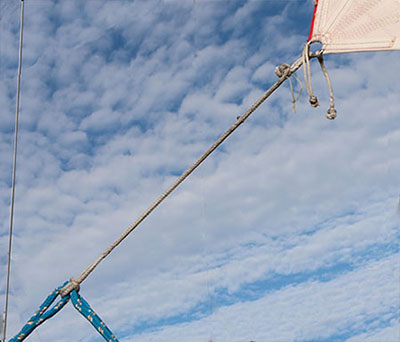
Spinnaker flying from a y-sheet.
The two additional diamond knot loops are for my light air sheets. Using two diamond knots allows me to use either one or two sheets.
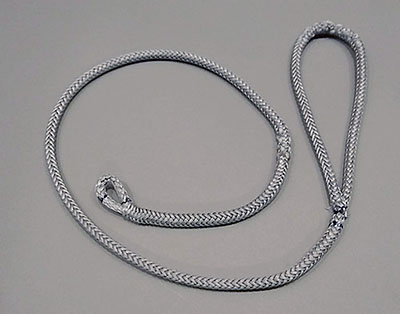 This picture above shows what the soft shackle y-sheet looks like. This y-sheet was made with the first method listed above. There is a large fixed eye at one and and a small soft shackle adjustable eye at the other end. The large eye attaches to the sheets and the small eye attaches to a diamond "stopper knot" that is luggage tagges to the clew ring.
This picture above shows what the soft shackle y-sheet looks like. This y-sheet was made with the first method listed above. There is a large fixed eye at one and and a small soft shackle adjustable eye at the other end. The large eye attaches to the sheets and the small eye attaches to a diamond "stopper knot" that is luggage tagges to the clew ring.
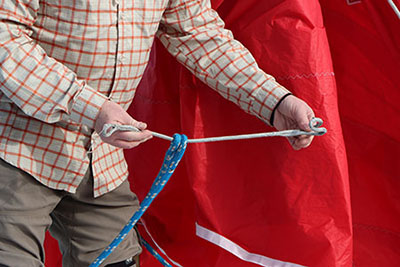
The sheets have eye splices in them and you pass the y-sheet through these eyes.
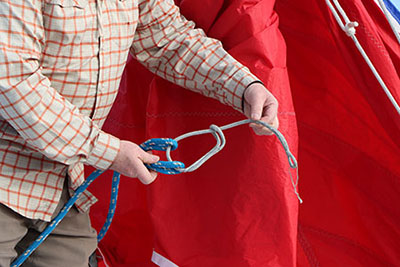
Next you pass the end of the y-sheet through its eye.
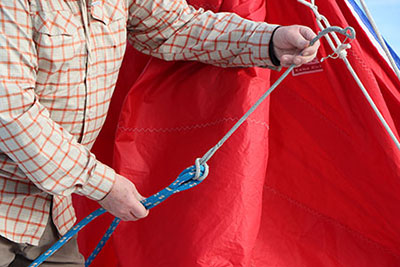
Snug it up. The compressive force of the sheets on the loop is what holds this short splice together and gives it its strength.
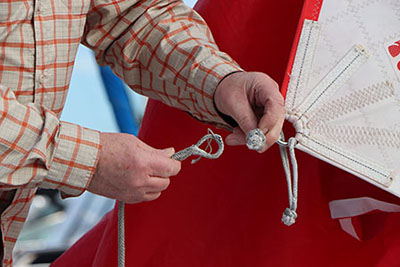
Use the small lanyard to pull the soft shackle eye open. The diamond knot on the spinnaker clue it made from one size larger Amsteel to give it a compatible strength.
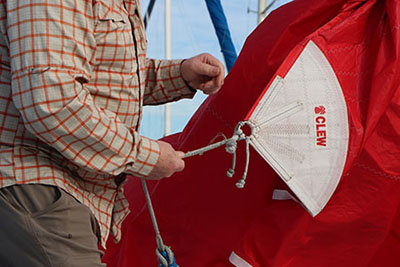
Pass the open eye over the diamond knot and cinch it up. This is much easier to do than using a traditional soft shackle. It only takes two hands instead of three ;-)

A close up of the sheets connected to the y-sheet large loop. The loop gets tight when the spinnaker fills.

A close up of the spinnaker clue with the Y-Sheet soft shackle eye attached to the diamond stopper knot. You may notice two smaller diamond knot stopper knots. I use these for my Ultra-Lite sheets that have a section of Amsteel with a soft shackle loop at the end. I can put just one sheet on and then add another if I need to tack or jibe depending on what sail is flying. I will do an atricle in them next.
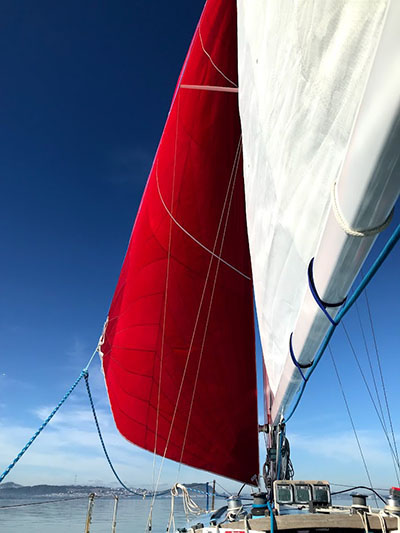
Finally, these are not just for spinnakers. Here is my free flying 155 jib. Using the soft shackle y-sheet is easier than using a soft shackle and provides a smooth surface for snag free tacks.
NOTICE: Some pages have affiliate links to Amazon. As an Amazon Associate, I earn from qualifying purchases. Please read website Cookie, Privacy, and Disclamers by clicking HERE. To contact me click HERE. For my YouTube page click HERE